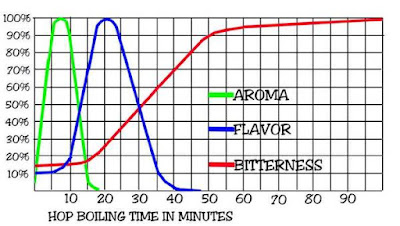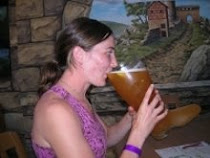One thing you have to perfect if you are to become a complete brewer, is how to taste beer. While it doesn't sound that hard, it actually is quite difficult when you don't always know what you're trying to taste for.
Here's what I've gathered so far:
Tasting beer can be broken up into 3 different senses:
Appearance
Smell
Taste
AppearanceWhat color is the beer? How clear is it? How does it retain it's head?
Color:
Colors of beer range from near clear (Bud Light) to black (Guiness). The color of a beer is determined by the grains that create it. BOTH grain color and beer color are commonly determined on a scale known as Lovibond or abreviated as °L. The Lovibond ranges from a scale of 1 to 600. When one is talking about grains, a Lovibond rating of a few hundred and above is considered quite dark, while when one is talking about beer, anything over 25 is considered to be black.
Various beer colors and grain colors.
Clarity:
How much suspended sediment is present in the brew. This is usually known as "Turbidity"
Head Retention:
Carbonation in a beer can add a significant amount of body. I still know a lot of people who drink their beers from a bottle. Unfortunately this is not the way the brewmaster wanted his product to be enjoyed. A good beer is meant to be poured. Pouring helps release a moderate amount of carbonation, which will give beer a more robust aroma, and it helps to release part of the bitterness of the carbonation. A good beer should have a thick white head that leaves a good head lace or "Brussels" on the side of the glass as you drink it.
SmellWhat are the scents you recieve after you pour the beer? What is contributed by the grains or other additives? What is contributed by the hops? Can you smell an odor?
Aroma:
Aroma describes the smells of a freshly poured beer that have been contribued by the malts, grains, or anything else besides hops. These aromas are usually described as being malty, nutty, fruity, sweet, grainy, yeasty, etc. I think a trick for the new taster such as myself is being able to pick these out. This is quite challenging at first, because you're tempted to say "It just smells like beer!" Creating my own beer has opened my eyes to the different components of these aromas, and has allowed me to start to smell for them specifically.
Bouquet:
The bouquet of a beer is the contribution from the hops. The bouquet is present initially after the pour, and then rapidly dissipates. Bouquet smells include: piney, citrusy, herbal, spicey, etc.
Odor:
Odor is usually attributed to a defect in the beer. These defects can be such thing as: bleachy, skunky, sulphury, etc.
TasteWhat are the flavors present in the beer? Does the beer feel light of heavy in the mouth? What kind of finish does it leave the palate?
Mouthfeel:
The mouthfeel of a beer is the subjective description of how a beer feels in the mouth. This feel is deteremined by the unferementables sugars and proteins in the beer. The 3 categories usually describing mouthfeel is light, medium, or full. I kind of think of it as how thick a beer feels in my mouth.
Flavor:
Flavor for me is still the hardest part of a beer to diagnose. Mainly because I haven't done it that much. When you first take a sip of a beer, make sure you move the drink over all parts of your tongue. This helps to make sure you use all different sections of your taste buds (sweet, salty, etc). Do you taste nutty, fruity, bananaesque, green apples, butter, earthy, etc? Are their strong hop tones? What about malty or yeastiness? Try to distinguish particular flavors that seem familiar.
Finish:
The last part of the beer tasting will be the finish. After the swallow/spit, how does your palate feel? Does the beer leave your mouth with a crisp fresh feeling? What about a bitter hop taste? Does the flavor last for a long time on your palate or quickly dissipate?
In the mail yesterday I recieved a free
Killians Irish Red tasting Kit. Inside it has 4 tasting glasses, a nice bottle opener, tasting mat, and a short book on beer tasting. I intend to use this as much as possible!
Harrika's Brew House in Cedar Point has a huge amount of craft and smaller brews. I intend to try as many that are there as possible!
If you're still a beginner taster like myself, I suggest finding brew reviews of the beer you have online. Doing this allows you to taste the beer, and compare what you taste to what others are tasting. This has helped me pick out particular flavors that I didn't understand and didn't know how to discern.























 Everything is Ready to Go!
Everything is Ready to Go!


















 Leah and I finished this Franzi boot off in the Dells!
Leah and I finished this Franzi boot off in the Dells!





